1 Regulating Soil Quality 2 Soil functions
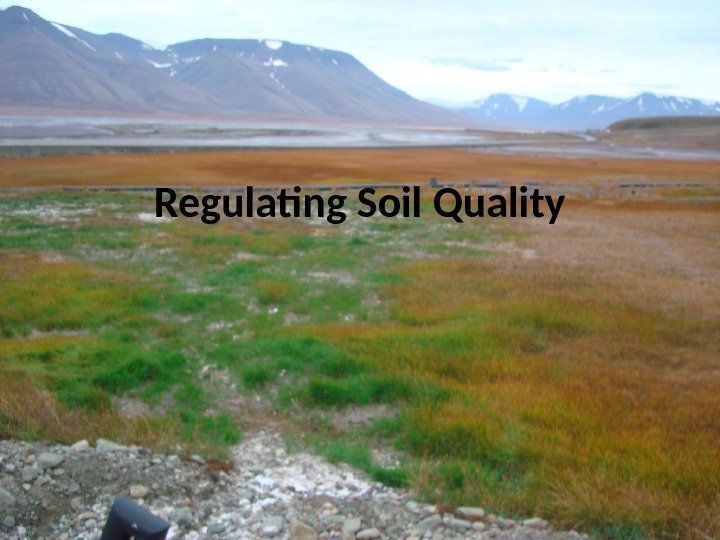
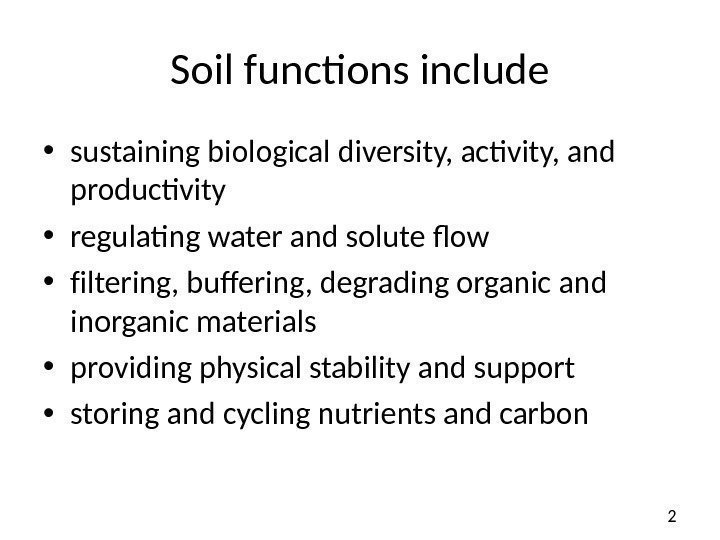
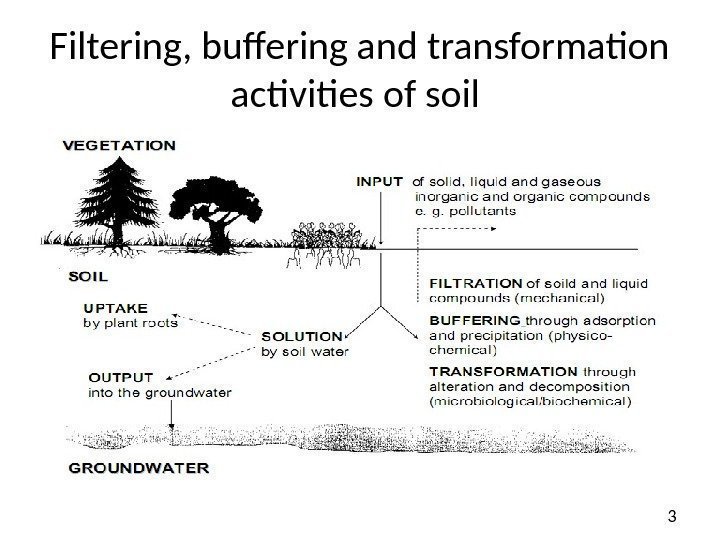
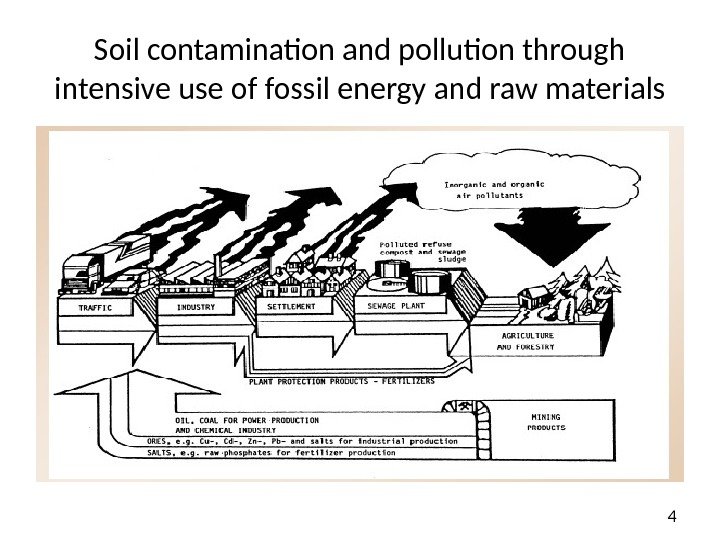
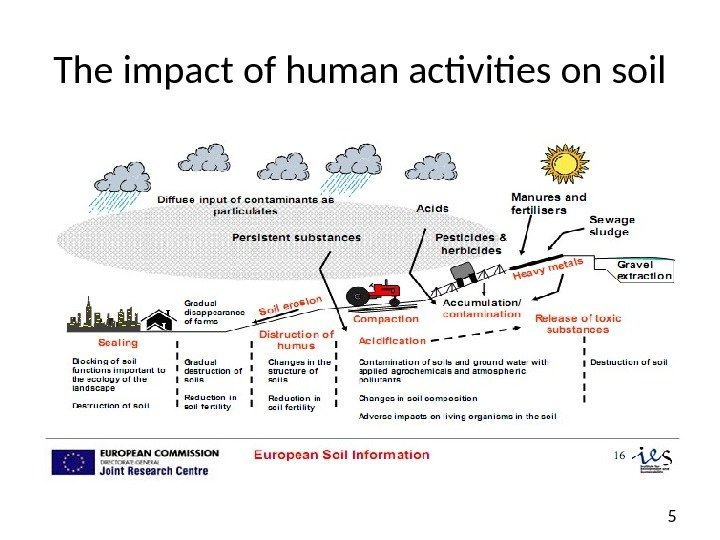
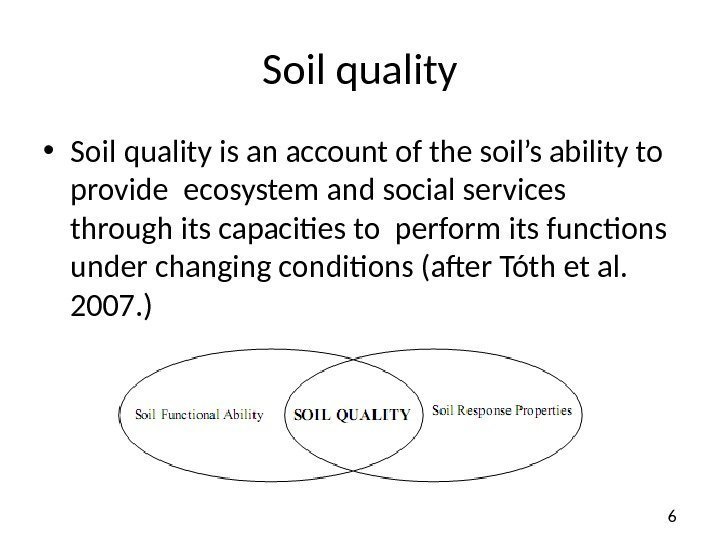
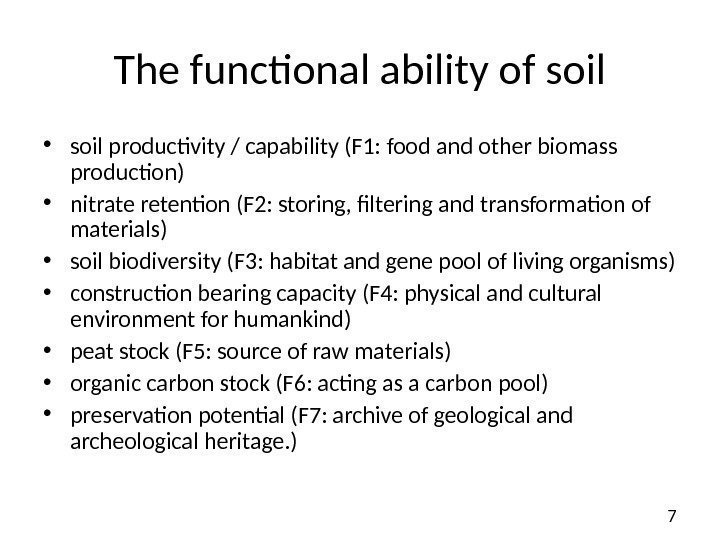
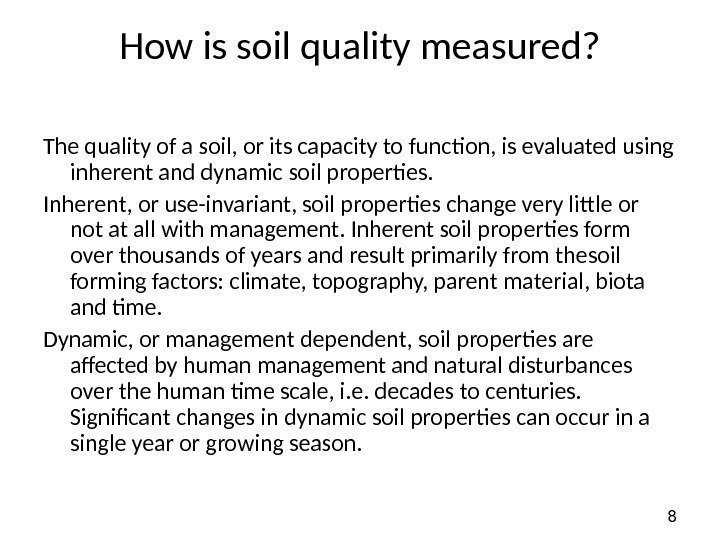
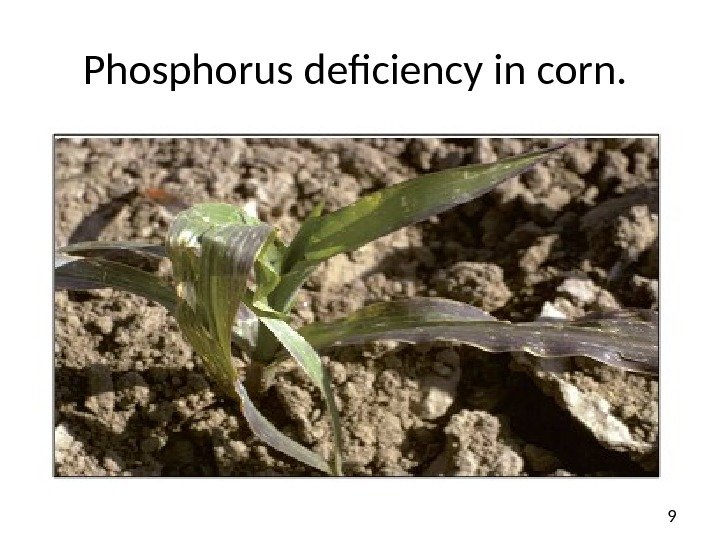
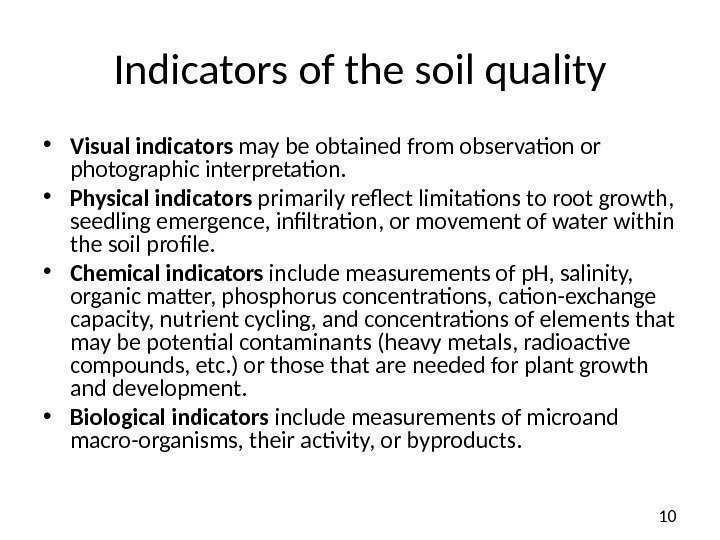
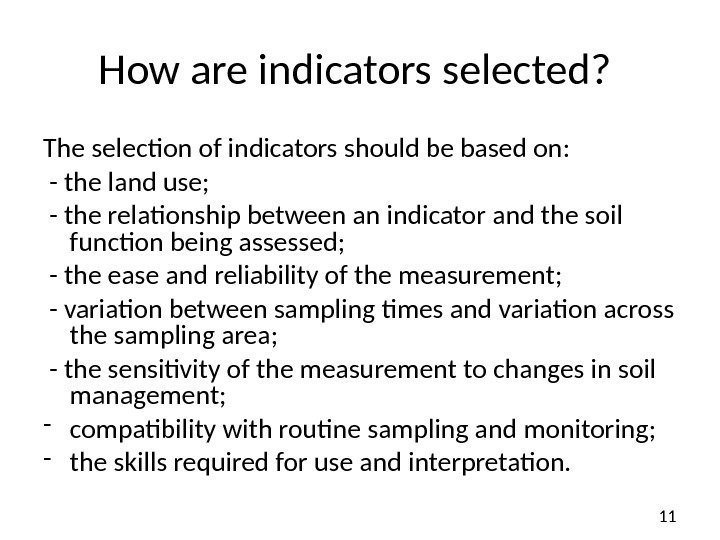
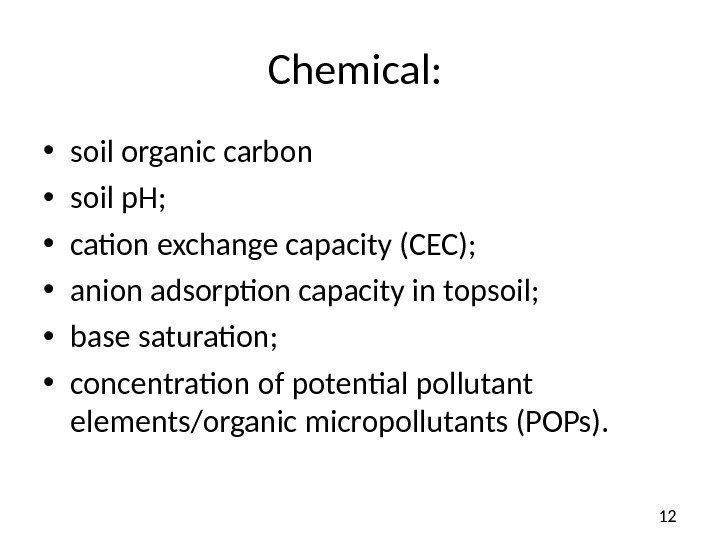
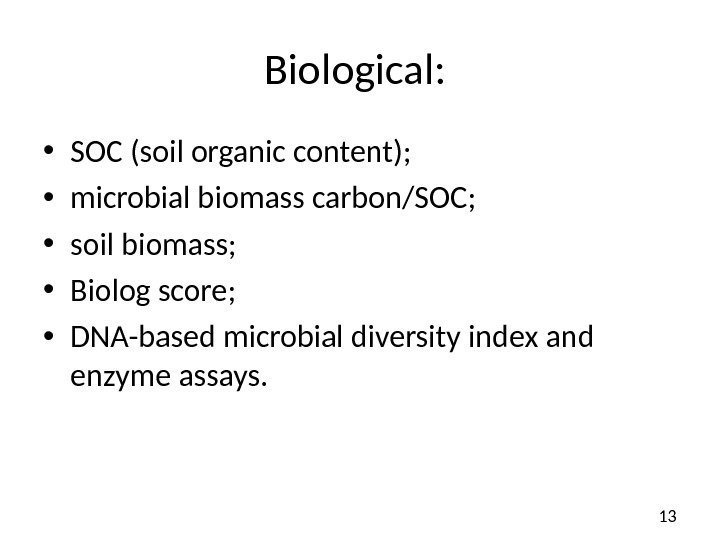
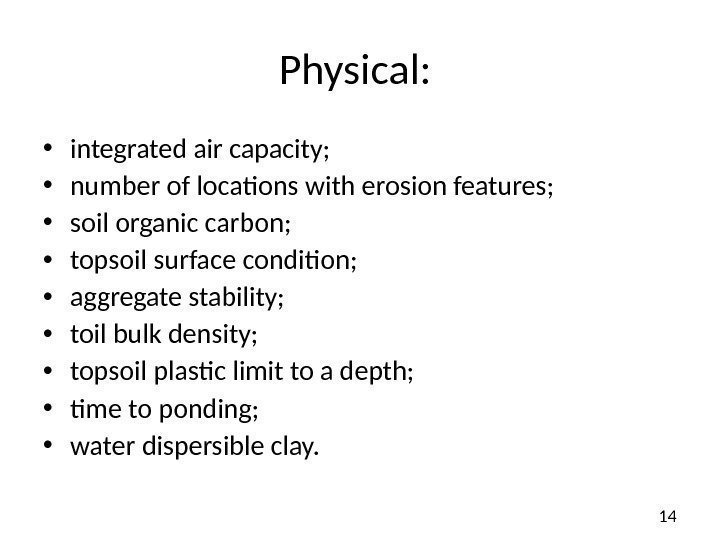
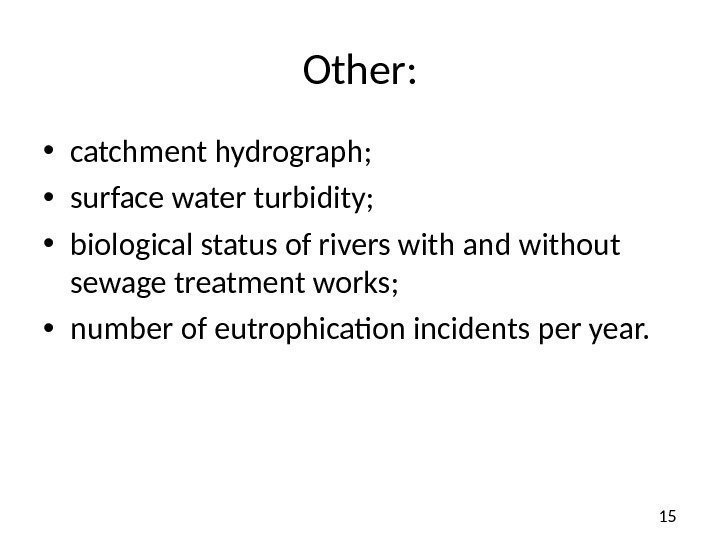
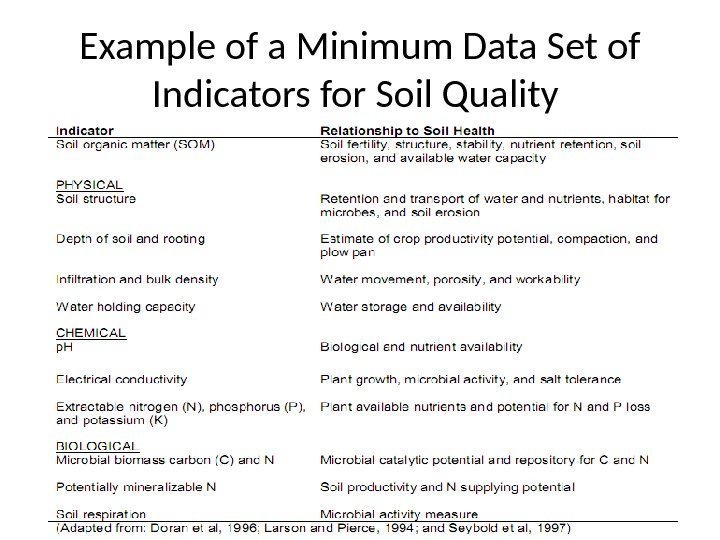
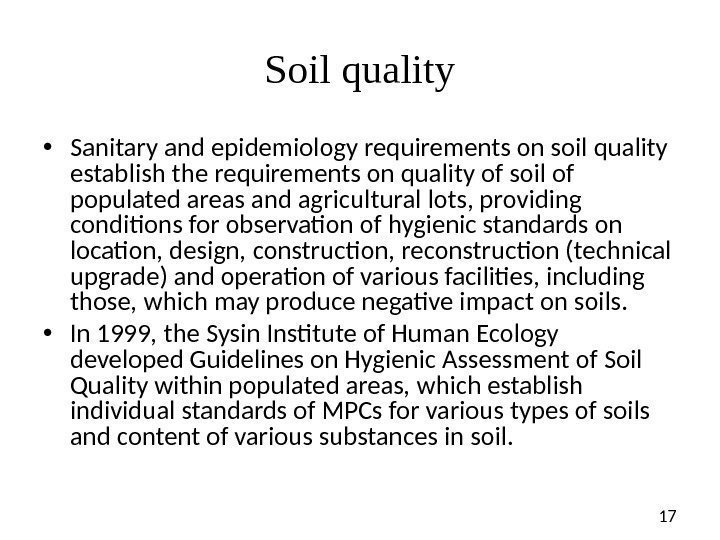
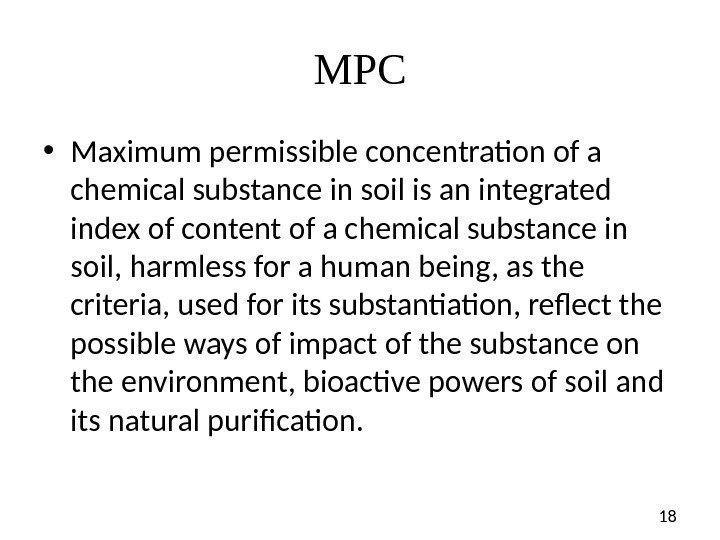
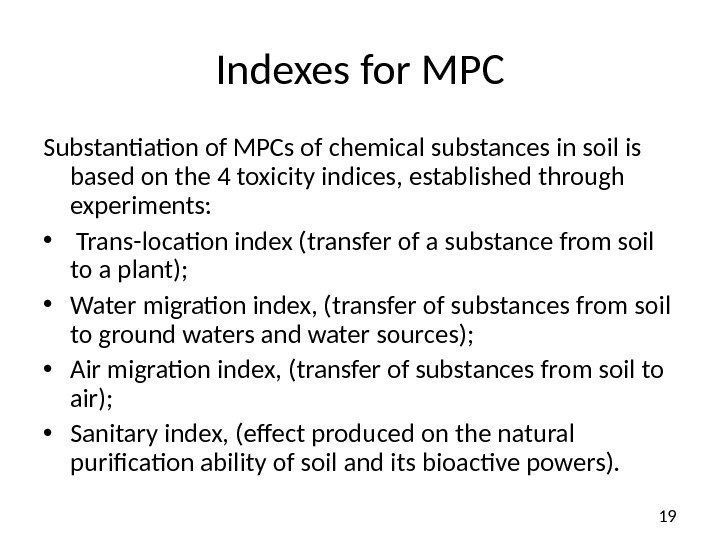
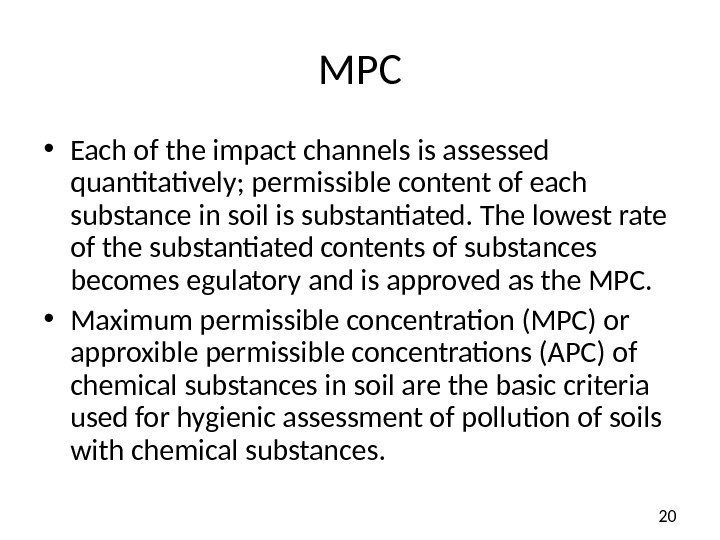
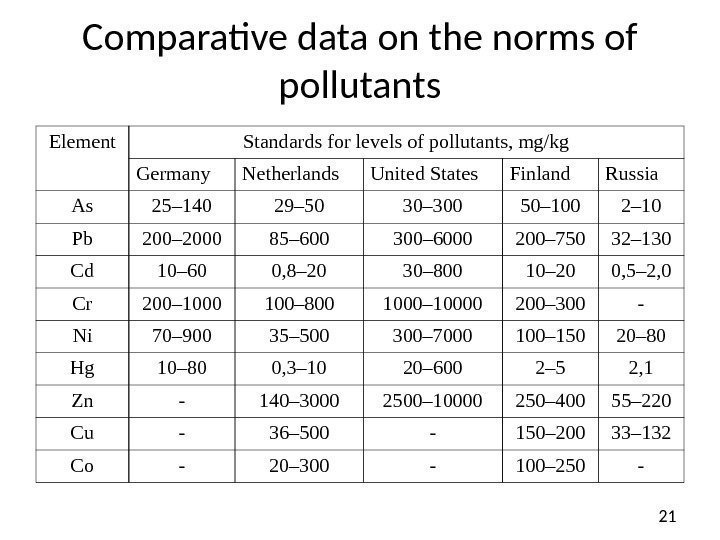
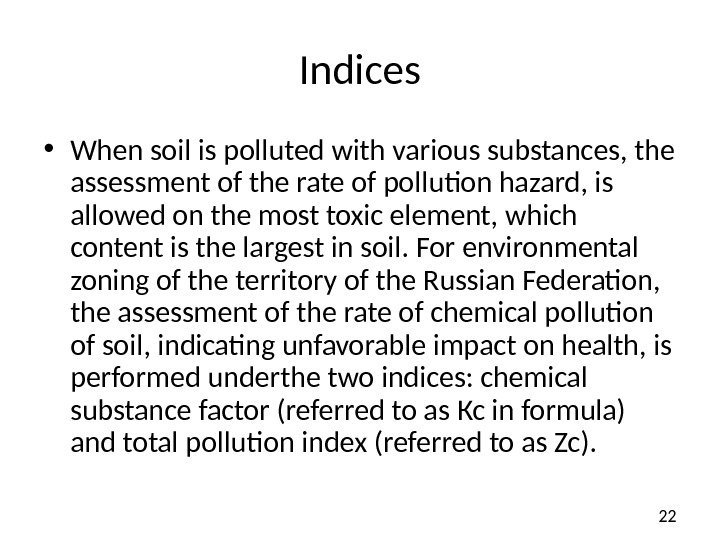
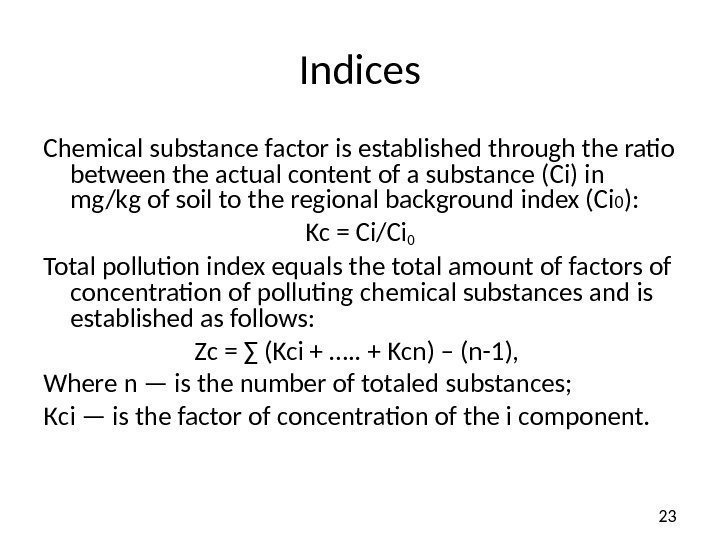
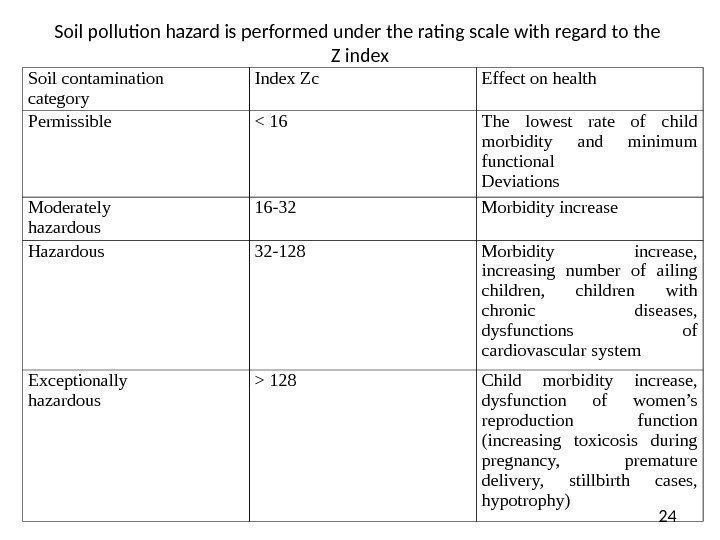
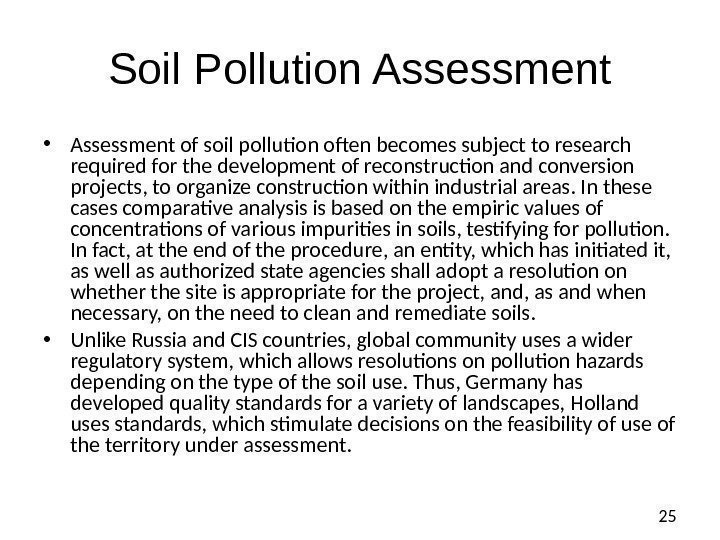
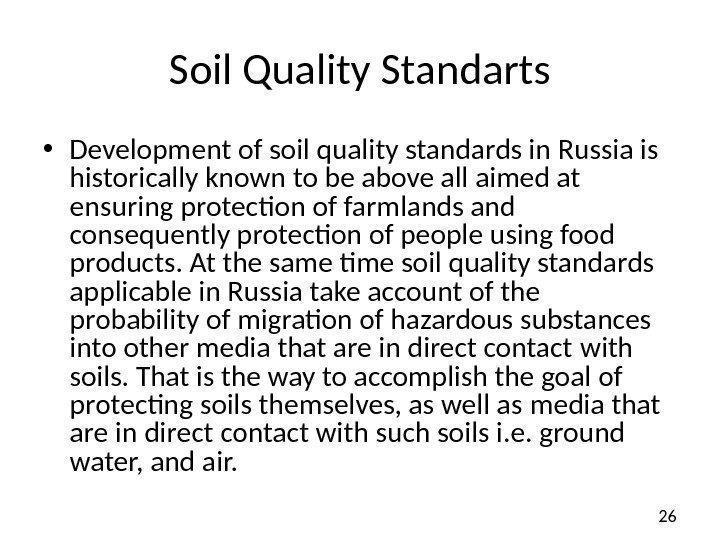
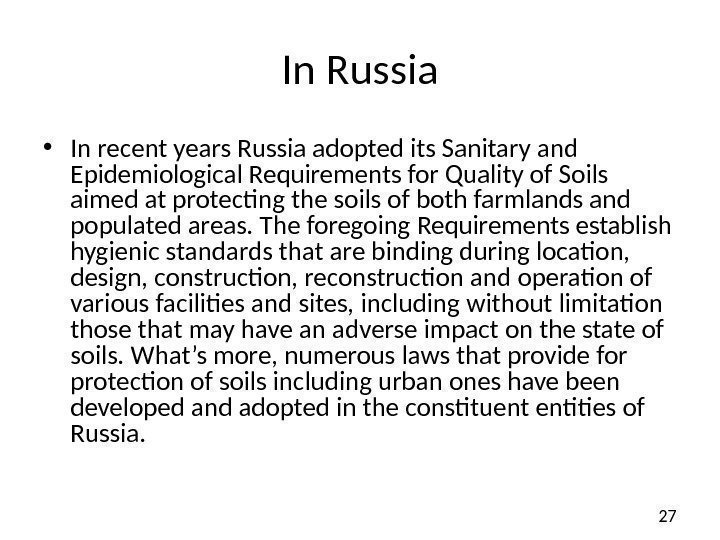
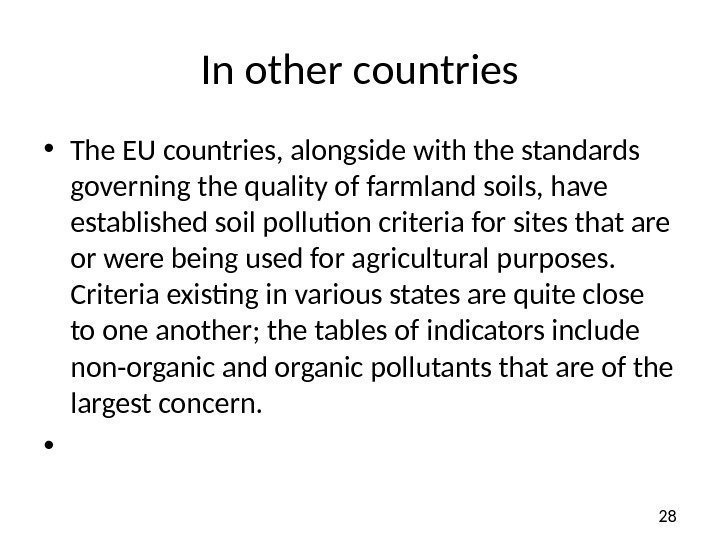
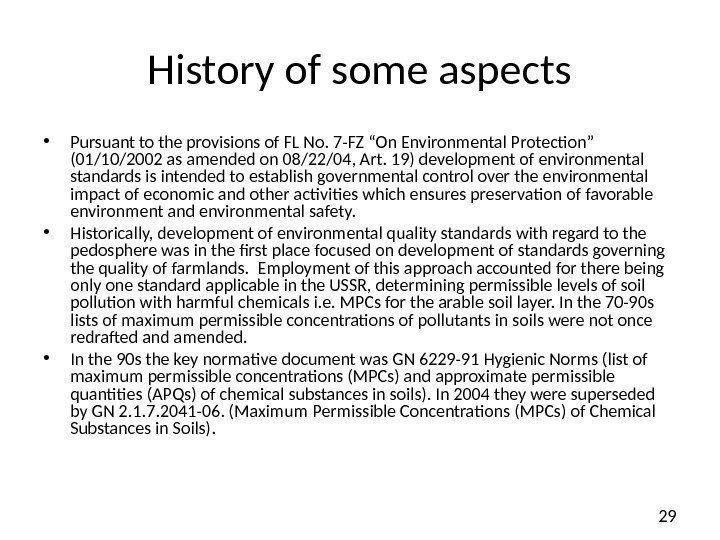
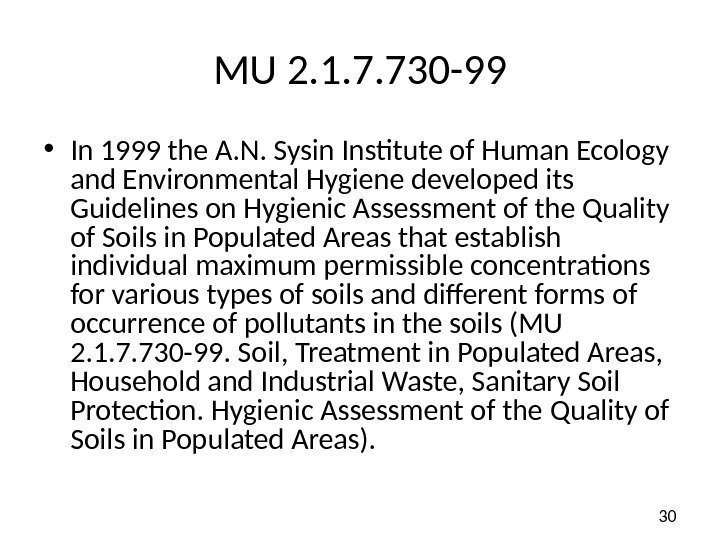
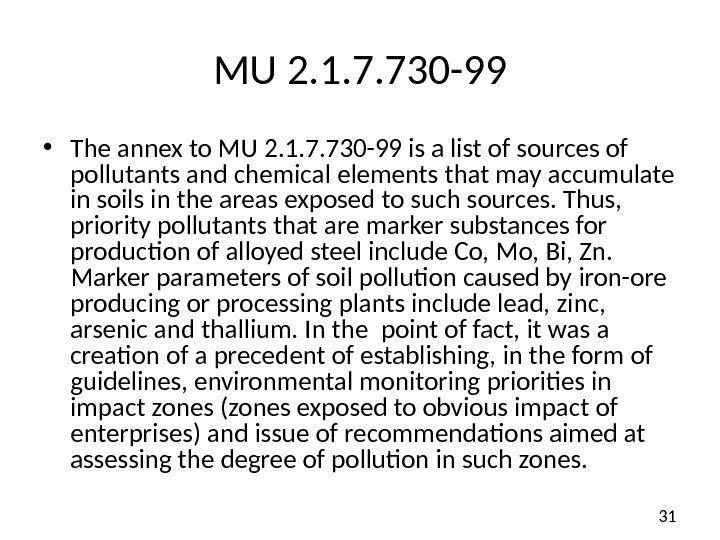
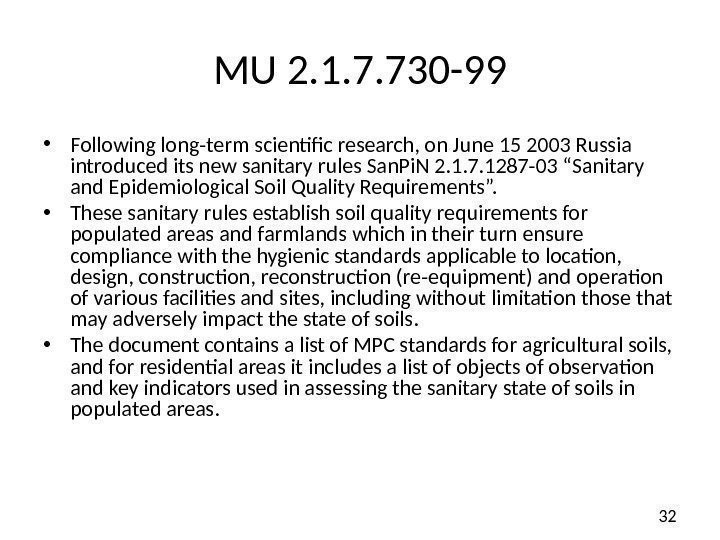
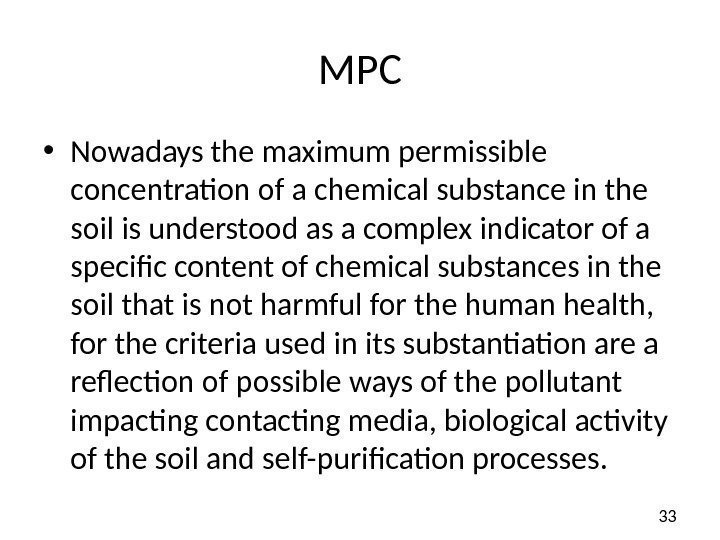

3_regulating_soil_quality.ppt
- Размер: 1.8 Мб
- Автор:
- Количество слайдов: 34
Описание презентации 1 Regulating Soil Quality 2 Soil functions по слайдам
 1 Regulating Soil Quality
1 Regulating Soil Quality
 2 Soil functions include • sustaining biological diversity, activity, and productivity • regulating water and solute flow • f iltering, buffering, degrading organic and inorganic materials • providing physical stability and support • storing and cycling nutrients and carbon
2 Soil functions include • sustaining biological diversity, activity, and productivity • regulating water and solute flow • f iltering, buffering, degrading organic and inorganic materials • providing physical stability and support • storing and cycling nutrients and carbon
 3 Filtering, buffering and transformation activities of soil
3 Filtering, buffering and transformation activities of soil
 4 Soil contamination and pollution through intensive use of fossil energy and raw materials
4 Soil contamination and pollution through intensive use of fossil energy and raw materials
 5 The impact of human activities on soil
5 The impact of human activities on soil
 6 Soil quality • Soil quality is an account of the soil’s ability to provide ecosystem and social services through its capacities to perform its functions under changing conditions (after Tóth et al. 2007. )
6 Soil quality • Soil quality is an account of the soil’s ability to provide ecosystem and social services through its capacities to perform its functions under changing conditions (after Tóth et al. 2007. )
 7 The functional ability of soil • soil productivity / capability (F 1: food and other biomass production) • nitrate retention (F 2: storing, filtering and transformation of materials) • soil biodiversity (F 3: habitat and gene pool of living organisms) • construction bearing capacity (F 4: physical and cultural environment for humankind) • peat stock (F 5: source of raw materials) • organic carbon stock (F 6: acting as a carbon pool) • preservation potential (F 7: archive of geological and archeological heritage. )
7 The functional ability of soil • soil productivity / capability (F 1: food and other biomass production) • nitrate retention (F 2: storing, filtering and transformation of materials) • soil biodiversity (F 3: habitat and gene pool of living organisms) • construction bearing capacity (F 4: physical and cultural environment for humankind) • peat stock (F 5: source of raw materials) • organic carbon stock (F 6: acting as a carbon pool) • preservation potential (F 7: archive of geological and archeological heritage. )
 8 How is soil quality measured? The quality of a soil, or its capacity to function, is evaluated using inherent and dynamic soil properties. Inherent, or use-invariant, soil properties change very little or not at all with management. Inherent soil properties form over thousands of years and result primarily from the soil forming factors: climate, topography, parent material, biota and time. Dynamic, or management dependent, soil properties are affected by human management and natural disturbances over the human time scale, i. e. decades to centuries. Significant changes in dynamic soil properties can occur in a single year or growing season.
8 How is soil quality measured? The quality of a soil, or its capacity to function, is evaluated using inherent and dynamic soil properties. Inherent, or use-invariant, soil properties change very little or not at all with management. Inherent soil properties form over thousands of years and result primarily from the soil forming factors: climate, topography, parent material, biota and time. Dynamic, or management dependent, soil properties are affected by human management and natural disturbances over the human time scale, i. e. decades to centuries. Significant changes in dynamic soil properties can occur in a single year or growing season.
 9 Phosphorus deficiency in corn.
9 Phosphorus deficiency in corn.
 10 I ndicators of the soil quality • Visual indicators may be obtained from observation or photographic interpretation. • Physical indicators primarily reflect limitations to root growth, seedling emergence, infiltration, or movement of water within the soil profile. • Chemical indicators include measurements of p. H, salinity, organic matter, phosphorus concentrations, cation-exchange capacity, nutrient cycling, and concentrations of elements that may be potential contaminants (heavy metals, radioactive compounds, etc. ) or those that are needed for plant growth and development. • Biological indicators include measurements of microand macro-organisms, their activity, or byproducts.
10 I ndicators of the soil quality • Visual indicators may be obtained from observation or photographic interpretation. • Physical indicators primarily reflect limitations to root growth, seedling emergence, infiltration, or movement of water within the soil profile. • Chemical indicators include measurements of p. H, salinity, organic matter, phosphorus concentrations, cation-exchange capacity, nutrient cycling, and concentrations of elements that may be potential contaminants (heavy metals, radioactive compounds, etc. ) or those that are needed for plant growth and development. • Biological indicators include measurements of microand macro-organisms, their activity, or byproducts.
 11 How are indicators selected? The selection of indicators should be based on: — the land use; — the relationship between an indicator and the soil function being assessed; — the ease and reliability of the measurement; — variation between sampling times and variation across the sampling area; — the sensitivity of the measurement to changes in soil management; — compatibility with routine sampling and monitoring; — the skills required for use and interpretation.
11 How are indicators selected? The selection of indicators should be based on: — the land use; — the relationship between an indicator and the soil function being assessed; — the ease and reliability of the measurement; — variation between sampling times and variation across the sampling area; — the sensitivity of the measurement to changes in soil management; — compatibility with routine sampling and monitoring; — the skills required for use and interpretation.
 12 Chemical: • s oil organic carbon • soil p. H; • cation exchange capacity (CEC); • anion adsorption capacity in topsoil; • base saturation; • concentration of potential pollutant elements/organic micropollutants (POPs).
12 Chemical: • s oil organic carbon • soil p. H; • cation exchange capacity (CEC); • anion adsorption capacity in topsoil; • base saturation; • concentration of potential pollutant elements/organic micropollutants (POPs).
 13 Biological: • SOC (soil organic content) ; • microbial biomass carbon/SOC; • soil biomass; • Biolog score ; • DNA-based microbial diversity index and enzyme assays.
13 Biological: • SOC (soil organic content) ; • microbial biomass carbon/SOC; • soil biomass; • Biolog score ; • DNA-based microbial diversity index and enzyme assays.
 14 Physical: • integrated air capacity; • number of locations with erosion features; • s oil organic carbon; • topsoil surface condition; • aggregate stability; • toil bulk density; • topsoil plastic limit to a depth; • time to ponding; • water dispersible clay.
14 Physical: • integrated air capacity; • number of locations with erosion features; • s oil organic carbon; • topsoil surface condition; • aggregate stability; • toil bulk density; • topsoil plastic limit to a depth; • time to ponding; • water dispersible clay.
 15 Other: • catchment hydrograph; • surface water turbidity; • biological status of rivers with and without sewage treatment works; • number of eutrophication incidents per year.
15 Other: • catchment hydrograph; • surface water turbidity; • biological status of rivers with and without sewage treatment works; • number of eutrophication incidents per year.
 16 Example of a Minimum Data Set of Indicators for Soil Quality
16 Example of a Minimum Data Set of Indicators for Soil Quality
 17 Soil quality • Sanitary and epidemiology requirements on soil quality establish the requirements on quality of soil of populated areas and agricultural lots, providing conditions for observation of hygienic standards on location, design, construction, reconstruction (technical upgrade) and operation of various facilities, including those, which may produce negative impact on soils. • In 1999, the Sysin Institute of Human Ecology developed Guidelines on Hygienic Assessment of Soil Quality within populated areas, which establish individual standards of MPCs for various types of soils and content of various substances in soil.
17 Soil quality • Sanitary and epidemiology requirements on soil quality establish the requirements on quality of soil of populated areas and agricultural lots, providing conditions for observation of hygienic standards on location, design, construction, reconstruction (technical upgrade) and operation of various facilities, including those, which may produce negative impact on soils. • In 1999, the Sysin Institute of Human Ecology developed Guidelines on Hygienic Assessment of Soil Quality within populated areas, which establish individual standards of MPCs for various types of soils and content of various substances in soil.
 18 MP С • Maximum permissible concentration of a chemical substance in soil is an integrated index of content of a chemical substance in soil, harmless for a human being, as the criteria, used for its substantiation, reflect the possible ways of impact of the substance on the environment, bioactive powers of soil and its natural purification.
18 MP С • Maximum permissible concentration of a chemical substance in soil is an integrated index of content of a chemical substance in soil, harmless for a human being, as the criteria, used for its substantiation, reflect the possible ways of impact of the substance on the environment, bioactive powers of soil and its natural purification.
 19 Indexes for MPC Substantiation of MPCs of chemical substances in soil is based on the 4 toxicity indices, established through experiments: • Trans-location index (transfer of a substance from soil to a plant); • Water migration index, (transfer of substances from soil to ground waters and water sources); • Air migration index, (transfer of substances from soil to air); • Sanitary index, (effect produced on the natural purification ability of soil and its bioactive powers).
19 Indexes for MPC Substantiation of MPCs of chemical substances in soil is based on the 4 toxicity indices, established through experiments: • Trans-location index (transfer of a substance from soil to a plant); • Water migration index, (transfer of substances from soil to ground waters and water sources); • Air migration index, (transfer of substances from soil to air); • Sanitary index, (effect produced on the natural purification ability of soil and its bioactive powers).
 20 MPC • Each of the impact channels is assessed quantitatively; permissible content of each substance in soil is substantiated. The lowest rate of the substantiated contents of substances becomes egulatory and is approved as the MPC. • Maximum permissible concentration (MPC) or approxible permissible concentrations (APC) of chemical substances in soil are the basic criteria used for hygienic assessment of pollution of soils with chemical substances.
20 MPC • Each of the impact channels is assessed quantitatively; permissible content of each substance in soil is substantiated. The lowest rate of the substantiated contents of substances becomes egulatory and is approved as the MPC. • Maximum permissible concentration (MPC) or approxible permissible concentrations (APC) of chemical substances in soil are the basic criteria used for hygienic assessment of pollution of soils with chemical substances.
 21 Comparative data on the norms of pollutants Element Standards for levels of pollutants, mg/kg Germany Netherlands United States Finland Russia As 25– 140 29– 50 30– 300 50– 100 2– 10 Pb 200– 2000 85– 600 300– 6000 200– 750 32– 130 Cd 10– 60 0, 8– 20 30– 800 10– 20 0, 5– 2, 0 Cr 200– 1000 100– 800 1000– 10000 200– 300 — Ni 70– 900 35– 500 300– 7000 100– 150 20– 80 Hg 10– 80 0, 3– 10 20– 600 2– 5 2, 1 Zn — 140– 3000 2500– 10000 250– 400 55– 220 Cu — 36– 500 — 150– 200 33– 132 Co — 20– 300 — 100– 250 —
21 Comparative data on the norms of pollutants Element Standards for levels of pollutants, mg/kg Germany Netherlands United States Finland Russia As 25– 140 29– 50 30– 300 50– 100 2– 10 Pb 200– 2000 85– 600 300– 6000 200– 750 32– 130 Cd 10– 60 0, 8– 20 30– 800 10– 20 0, 5– 2, 0 Cr 200– 1000 100– 800 1000– 10000 200– 300 — Ni 70– 900 35– 500 300– 7000 100– 150 20– 80 Hg 10– 80 0, 3– 10 20– 600 2– 5 2, 1 Zn — 140– 3000 2500– 10000 250– 400 55– 220 Cu — 36– 500 — 150– 200 33– 132 Co — 20– 300 — 100– 250 —
 22 Indices • When soil is polluted with various substances, the assessment of the rate of pollution hazard, is allowed on the most toxic element, which content is the largest in soil. For environmental zoning of the territory of the Russian Federation, the assessment of the rate of chemical pollution of soil, indicating unfavorable impact on health, is performed underthe two indices: chemical substance factor (referred to as Кс in formula) and total pollution index (referred to as Zc).
22 Indices • When soil is polluted with various substances, the assessment of the rate of pollution hazard, is allowed on the most toxic element, which content is the largest in soil. For environmental zoning of the territory of the Russian Federation, the assessment of the rate of chemical pollution of soil, indicating unfavorable impact on health, is performed underthe two indices: chemical substance factor (referred to as Кс in formula) and total pollution index (referred to as Zc).
 23 Indices Chemical substance factor is established through the ratio between the actual content of a substance ( С i) in mg/kg of soil to the regional background index (Сi 0 ): Kc = Ci/Ci 0 Total pollution index equals the total amount of factors of concentration of polluting chemical substances and is established as follows: Zc = ∑ (Kci + …. . + Kcn) – (n-1), W here n — is the number of totaled substances; Кci — is the factor of concentration of the i component.
23 Indices Chemical substance factor is established through the ratio between the actual content of a substance ( С i) in mg/kg of soil to the regional background index (Сi 0 ): Kc = Ci/Ci 0 Total pollution index equals the total amount of factors of concentration of polluting chemical substances and is established as follows: Zc = ∑ (Kci + …. . + Kcn) – (n-1), W here n — is the number of totaled substances; Кci — is the factor of concentration of the i component.
 24 Soil pollution hazard is performed under the rating scale with regard to the Z index Soil contamination category Index Zс Effect on health Permissible 128 Child morbidity increase, dysfunction of women’s reproduction function (increasing toxicosis during pregnancy, premature delivery, stillbirth cases, hypotrophy)
24 Soil pollution hazard is performed under the rating scale with regard to the Z index Soil contamination category Index Zс Effect on health Permissible 128 Child morbidity increase, dysfunction of women’s reproduction function (increasing toxicosis during pregnancy, premature delivery, stillbirth cases, hypotrophy)
 25 Soil Pollution Assessment • Assessment of soil pollution often becomes subject to research required for the development of reconstruction and conversion projects, to organize construction within industrial areas. In these cases comparative analysis is based on the empiric values of concentrations of various impurities in soils, testifying for pollution. In fact, at the end of the procedure, an entity, which has initiated it, as well as authorized state agencies shall adopt a resolution on whether the site is appropriate for the project, and, as and when necessary, on the need to clean and remediate soils. • Unlike Russia and CIS countries, global community uses a wider regulatory system, which allows resolutions on pollution hazards depending on the type of the soil use. Thus, Germany has developed quality standards for a variety of landscapes, Holland uses standards, which stimulate decisions on the feasibility of use of the territory under assessment.
25 Soil Pollution Assessment • Assessment of soil pollution often becomes subject to research required for the development of reconstruction and conversion projects, to organize construction within industrial areas. In these cases comparative analysis is based on the empiric values of concentrations of various impurities in soils, testifying for pollution. In fact, at the end of the procedure, an entity, which has initiated it, as well as authorized state agencies shall adopt a resolution on whether the site is appropriate for the project, and, as and when necessary, on the need to clean and remediate soils. • Unlike Russia and CIS countries, global community uses a wider regulatory system, which allows resolutions on pollution hazards depending on the type of the soil use. Thus, Germany has developed quality standards for a variety of landscapes, Holland uses standards, which stimulate decisions on the feasibility of use of the territory under assessment.
 26 Soil Quality Standarts • Development of soil quality standards in Russia is historically known to be above all aimed at ensuring protection of farmlands and consequently protection of people using food products. At the same time soil quality standards applicable in Russia take account of the probability of migration of hazardous substances into other media that are in direct contact with soils. That is the way to accomplish the goal of protecting soils themselves, as well as media that are in direct contact with such soils i. e. ground water, and air.
26 Soil Quality Standarts • Development of soil quality standards in Russia is historically known to be above all aimed at ensuring protection of farmlands and consequently protection of people using food products. At the same time soil quality standards applicable in Russia take account of the probability of migration of hazardous substances into other media that are in direct contact with soils. That is the way to accomplish the goal of protecting soils themselves, as well as media that are in direct contact with such soils i. e. ground water, and air.
 27 In Russia • In recent years Russia adopted its Sanitary and Epidemiological Requirements for Quality of Soils aimed at protecting the soils of both farmlands and populated areas. The foregoing Requirements establish hygienic standards that are binding during location, design, construction, reconstruction and operation of various facilities and sites, including without limitation those that may have an adverse impact on the state of soils. What’s more, numerous laws that provide for protection of soils including urban ones have been developed and adopted in the constituent entities of Russia.
27 In Russia • In recent years Russia adopted its Sanitary and Epidemiological Requirements for Quality of Soils aimed at protecting the soils of both farmlands and populated areas. The foregoing Requirements establish hygienic standards that are binding during location, design, construction, reconstruction and operation of various facilities and sites, including without limitation those that may have an adverse impact on the state of soils. What’s more, numerous laws that provide for protection of soils including urban ones have been developed and adopted in the constituent entities of Russia.
 28 In other countries • The EU countries, alongside with the standards governing the quality of farmland soils, have established soil pollution criteria for sites that are or were being used for agricultural purposes. Criteria existing in various states are quite close to one another; the tables of indicators include non-organic and organic pollutants that are of the largest concern. •
28 In other countries • The EU countries, alongside with the standards governing the quality of farmland soils, have established soil pollution criteria for sites that are or were being used for agricultural purposes. Criteria existing in various states are quite close to one another; the tables of indicators include non-organic and organic pollutants that are of the largest concern. •
 29 History of some aspects • Pursuant to the provisions of FL No. 7 -FZ “On Environmental Protection” (01/10/2002 as amended on 08/22/04, Art. 19) development of environmental standards is intended to establish governmental control over the environmental impact of economic and other activities which ensures preservation of favorable environment and environmental safety. • Historically, development of environmental quality standards with regard to the pedosphere was in the first place focused on development of standards governing the quality of farmlands. E mployment of this approach accounted for there being only one standard applicable in the USSR, determining permissible levels of soil pollution with harmful chemicals i. e. MPCs for the arable soil layer. In the 70 -90 s lists of maximum permissible concentrations of pollutants in soils were not once redrafted and amended. • In the 90 s the key normative document was GN 6229 -91 Hygienic Norms (list of maximum permissible concentrations (MPCs) and approximate permissible quantities (APQs) of chemical substances in soils). In 2004 they were superseded by GN 2. 1. 7. 2041 -06. (Maximum Permissible Concentrations (MPCs) of Chemical Substances in Soils).
29 History of some aspects • Pursuant to the provisions of FL No. 7 -FZ “On Environmental Protection” (01/10/2002 as amended on 08/22/04, Art. 19) development of environmental standards is intended to establish governmental control over the environmental impact of economic and other activities which ensures preservation of favorable environment and environmental safety. • Historically, development of environmental quality standards with regard to the pedosphere was in the first place focused on development of standards governing the quality of farmlands. E mployment of this approach accounted for there being only one standard applicable in the USSR, determining permissible levels of soil pollution with harmful chemicals i. e. MPCs for the arable soil layer. In the 70 -90 s lists of maximum permissible concentrations of pollutants in soils were not once redrafted and amended. • In the 90 s the key normative document was GN 6229 -91 Hygienic Norms (list of maximum permissible concentrations (MPCs) and approximate permissible quantities (APQs) of chemical substances in soils). In 2004 they were superseded by GN 2. 1. 7. 2041 -06. (Maximum Permissible Concentrations (MPCs) of Chemical Substances in Soils).
 30 MU 2. 1. 7. 730 -99 • In 1999 the A. N. Sysin Institute of Human Ecology and Environmental Hygiene developed its Guidelines on Hygienic Assessment of the Quality of Soils in Populated Areas that establish individual maximum permissible concentrations for various types of soils and different forms of occurrence of pollutants in the soils (MU 2. 1. 7. 730 -99. Soil, Treatment in Populated Areas, Household and Industrial Waste, Sanitary Soil Protection. Hygienic Assessment of the Quality of Soils in Populated Areas).
30 MU 2. 1. 7. 730 -99 • In 1999 the A. N. Sysin Institute of Human Ecology and Environmental Hygiene developed its Guidelines on Hygienic Assessment of the Quality of Soils in Populated Areas that establish individual maximum permissible concentrations for various types of soils and different forms of occurrence of pollutants in the soils (MU 2. 1. 7. 730 -99. Soil, Treatment in Populated Areas, Household and Industrial Waste, Sanitary Soil Protection. Hygienic Assessment of the Quality of Soils in Populated Areas).
 31 MU 2. 1. 7. 730 -99 • T he annex to MU 2. 1. 7. 730 -99 is a list of sources of pollutants and chemical elements that may accumulate in soils in the areas exposed to such sources. Thus, priority pollutants that are marker substances for production of alloyed steel include Co , Mo , Bi , Zn. Marker parameters of soil pollution caused by iron-ore producing or processing plants include lead, zinc, arsenic and thallium. In the p oint of fact, it was a creation of a precedent of establishing, in the form of guidelines, environmental monitoring priorities in impact zones (zones exposed to obvious impact of enterprises) and issue of recommendations aimed at assessing the degree of pollution in such zones.
31 MU 2. 1. 7. 730 -99 • T he annex to MU 2. 1. 7. 730 -99 is a list of sources of pollutants and chemical elements that may accumulate in soils in the areas exposed to such sources. Thus, priority pollutants that are marker substances for production of alloyed steel include Co , Mo , Bi , Zn. Marker parameters of soil pollution caused by iron-ore producing or processing plants include lead, zinc, arsenic and thallium. In the p oint of fact, it was a creation of a precedent of establishing, in the form of guidelines, environmental monitoring priorities in impact zones (zones exposed to obvious impact of enterprises) and issue of recommendations aimed at assessing the degree of pollution in such zones.
 32 MU 2. 1. 7. 730 -99 • Following long-term scientific research, on June 15 2003 Russia introduced its new sanitary rules San. Pi. N 2. 1. 7. 1287 -03 “Sanitary and Epidemiological Soil Quality Requirements”. • These sanitary rules establish soil quality requirements for populated areas and farmlands which in their turn ensure compliance with the hygienic standards applicable to location, design, construction, reconstruction (re-equipment) and operation of various facilities and sites, including without limitation those that may adversely impact the state of soils. • The document contains a list of MPC standards for agricultural soils, and for residential areas it includes a list of objects of observation and key indicators used in assessing the sanitary state of soils in populated areas.
32 MU 2. 1. 7. 730 -99 • Following long-term scientific research, on June 15 2003 Russia introduced its new sanitary rules San. Pi. N 2. 1. 7. 1287 -03 “Sanitary and Epidemiological Soil Quality Requirements”. • These sanitary rules establish soil quality requirements for populated areas and farmlands which in their turn ensure compliance with the hygienic standards applicable to location, design, construction, reconstruction (re-equipment) and operation of various facilities and sites, including without limitation those that may adversely impact the state of soils. • The document contains a list of MPC standards for agricultural soils, and for residential areas it includes a list of objects of observation and key indicators used in assessing the sanitary state of soils in populated areas.
 33 MPC • Nowadays the maximum permissible concentration of a chemical substance in the soil is understood as a complex indicator of a specific content of chemical substances in the soil that is not harmful for the human health, for the criteria used in its substantiation are a reflection of possible ways of the pollutant impacting contacting media, biological activity of the soil and self-purification processes.
33 MPC • Nowadays the maximum permissible concentration of a chemical substance in the soil is understood as a complex indicator of a specific content of chemical substances in the soil that is not harmful for the human health, for the criteria used in its substantiation are a reflection of possible ways of the pollutant impacting contacting media, biological activity of the soil and self-purification processes.

